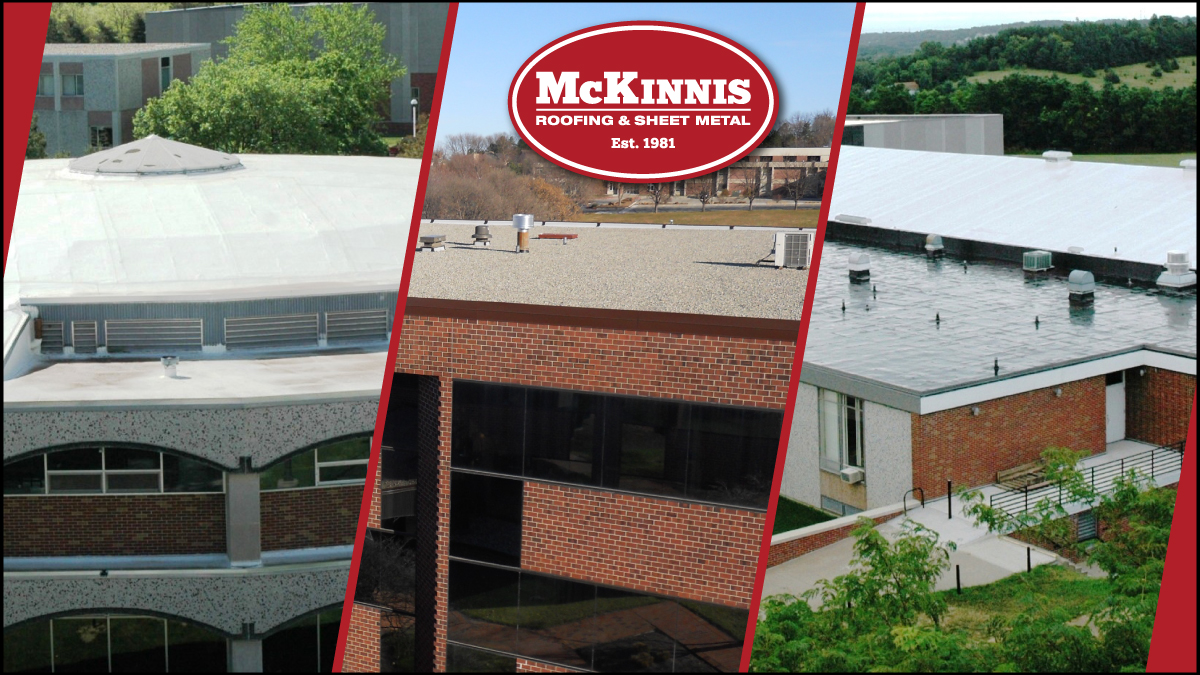
Have you ever wondered if flat roofs are truly level? In reality, even flat roofs require a slight pitch, usually around ¼ inch per foot, and roof crickets or saddles may have a steeper slope of ½ inch per foot. This design is essential to facilitate proper drainage and redirect water effectively. This means they are not entirely ‘flat’ and still require careful design and maintenance considerations. Interestingly, this gentle slope causes flat roofs to retain snow and water for more extended periods compared to steeply pitched roofs, requiring a completely different waterproofing material. Unlike standard sloped roofs that rely on overlapping shingles for water runoff, flat roofs are crafted as continuous surfaces capable of temporarily holding standing water.
Flat Roofs: The Hidden Slope for Proper Drainage
Types of Flat Roofs
There are three main types of flat roof systems:
1. Built-up roofing (BUR)
The traditional hot-tar-and-gravel roof is built from three or more piles of waterproof material alternated with hot tar and finished with a top layer of aggregate, such as stone, gravel, or cap sheets.
2. Modified bitumen roofing (MBR)
MBR is a flexible asphalt-based material with a mineral top coating, similar to traditional asphalt shingles. Installation methods include “torch-down,” involving heating the material as it’s unrolled, and self-adhesive options.
3. Membrane (Single-Ply) Roofing
Ethylene Propylene Diene Monomer (EPDM) and Thermoplastic Polyolefin (TPO) are two of the most common materials used in modern commercial roofing.
- TPO – TPO can be installed through two primary methods: mechanical attachment with plates and fasteners or fully adhered with bonding adhesives. The seams are heat-welded together with specialized equipment and tools.
- EPDM – EPDM offers multiple installation options including mechanical fastening, full adherence, or ballasting. In ballasted EPDM systems, the membrane is placed loosely on the roof surface and held in place with gravel, river-washed stones, or concrete pavers. The seams are fused with a specialized bonding adhesive and tape.
Ultimately, the suitability of a flat roof depends on factors like climate, building design, intended use, and maintenance resources. It’s important to weigh the pros and cons carefully when deciding on the right roofing type for your specific needs.
Pros of Flat Roofing
Aesthetic Flexibility
Flat roofs allow for versatile design options, such as rooftop gardens, outdoor living spaces, solar panel installations, and more.
Accessibility
Flat roofs are easily accessible, making maintenance, repairs, and installations of equipment like HVAC systems and solar panels more convenient.
Space Utilization
The horizontal surface of flat roofs can be utilized for storage or recreational purposes, making them functional for specific applications.
Energy Efficiency
Flat roofs can accommodate cool roofing materials and solar reflectivity features, contributing to energy savings by reducing heat absorption and improving insulation.
Cost Savings
Flat roofs can be more cost-effective to construct than pitched roofs, especially when it comes to materials and labor.
Cons of Flat Roofing:
Drainage Issues
The lack of significant pitch can lead to water pooling, which can cause leaks and deterioration over time if not managed properly.
Maintenance
Flat roofs require consistent maintenance to prevent water accumulation, and premature deterioration; making regular inspections and upkeep essential.
Installation Challenges
Proper installation of flat roofs is critical, as incorrect installation can lead to water penetration, structural issues, and other problems.
Roofing Material Selection
The choice of roofing materials for flat roofs is crucial; using the wrong materials can lead to leaks, water accumulation, and premature deterioration.
No matter what style of roof you go with for your home or business, it’s important to establish a good relationship with a reputable, licensed roofer who can help you with maintenance, inspections, and repairs.
Omaha Roofing Professionals
When you partner with McKinnis Roofing & Sheet Metal you will get every ounce of our energy and enthusiasm and all the attention you need to feel good about your choice. Give us a call today or fill out our contact form to learn more about the roofing systems we offer.
TRUST THE EXPERTS AT MCKINNIS
If you are in need of a roof inspection, roof replacement, or windows, siding, and gutter work, give us a call today at 402-426-2644, visit our website at www.mckinnisinc.com, or fill out our contact form. Our Omaha roofing and exterior experts are highly trained and always ready to help!


